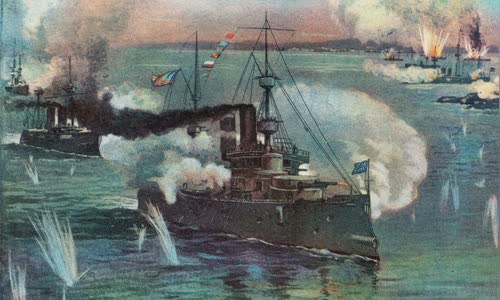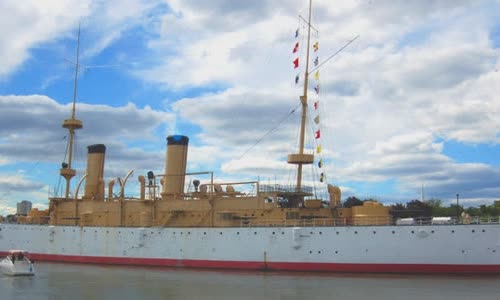Cruiser USS Olympia was a major contributor to the battle of destroying the powerful Spanish fleet in 1898, though it was criticized as too small.
When commissioned for the US Navy in January 1895, cruiser USS Olympia was expected to survive the onslaught due to high speed, thick steel casing and strong firepower.

Painting of USS Olympia during a battle in Manila Bay on April 27, 1898 Photo: Wikipedia
In fact, this warship wiped out an enemy fleet, then shored the coast and escorted it during 27 years of service.
At the end of the 19th century, the United States had difficulty finding naval developments for the following years.
The U.S. Navy must build ships to protect the coast with a limited budget and at the same time be ready to serve the goal of deploying the power of many presidents.
To meet the above requirements, the US Navy decided to build a whole new fleet of steel-armored cruisers, equipped with steam engines but still with masts to take advantage of the wind as needed.
Due to tight funding, the ships would focus on firepower and maneuverability, instead of wearing thick steel armor like the battleships of the European contemporaries.
The star of the new fleet was the C-6, an armored cruiser launched in 1892 and commissioned a year later as the USS Olympia, named after the then state capital of Washington.
USS Olympia fits all requirements of the new navy development plan.
It was armed with four 203 mm Mark 4 main guns in the bow and stern turrets.

USS Olympia as a museum ship in Philadelphia in 2007 Photo: Wikipedia
Some observers then criticized the design, arguing that it was overpowered with firepower compared to a cruiser and was no different from a miniature battleship.
USS Olympia was deployed to the Pacific Ocean before the cruiser USS Maine exploded and sank at the port of Havana in February 1898.
The squad led by USS Olympia under the command of Admiral George Dewey was sent to Manila Bay, Philippines, on April 27, 1898 to attack the Spanish fleet here.
The American flotilla moved in two rows behind the USS Olympia as it approached the battlefield.
The Spanish fleet was anchored near the shore under the protection of coastal defense artillery.
Spanish warships and defensive guns were less accurate than the United States, making the battle quickly tilted toward the USS Olympia.
USS Olympia and Admiral Dewey became famous after the battle.
However, the USS Olympia could not compete with modern battleships after World War I and was eliminated in 1922, becoming a museum for visitors in Philadelphia from 1958.



 Ester Jamisola
Ester Jamisola







